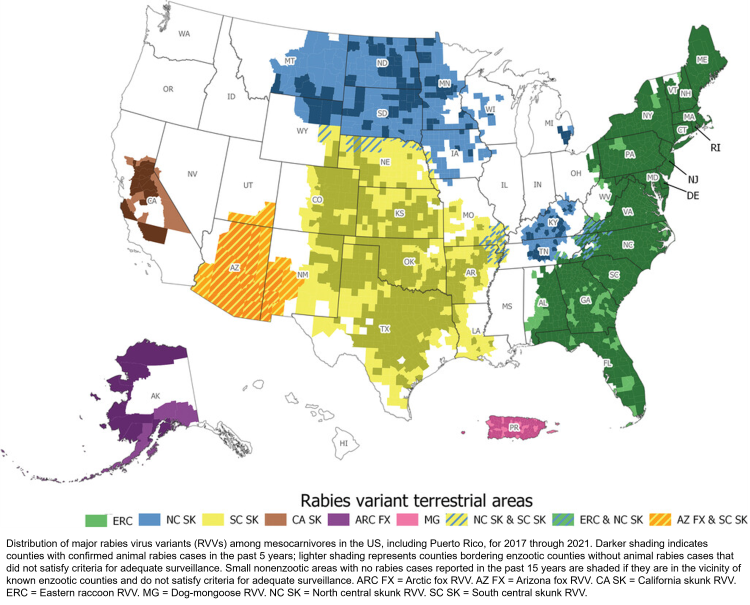Government mail service may be affected by the Canada Post labour disruption. Learn about how critical government mail will be handled.
Overview
There are many strains, or variants, of rabies virus, each adapted to a particular reservoir species. The reservoir species maintains the presence of the virus in nature.
All variants are capable of causing rabies in other animals.
Alberta
In Alberta, bats are the only reservoir of the rabies virus. However, it is possible for other animals to become infected with and transmit bat rabies. Spillover of bat rabies to other animals, which is most commonly observed in cats, generally does not result in sustained outbreaks.
Rabies variants of terrestrial species – that is, mammals other than bats – have been present in Alberta in the past and could be reintroduced in the future.
In the 1950s, an epizootic (animal outbreak) of arctic fox rabies variant started at the northern Alberta border and spread rapidly throughout the province. Through the 1970s, 80s and 90s, epizootics of the prairie skunk rabies variant occurred sporadically. These outbreaks were controlled and eradicated through the work of many individuals and agencies, coordinated through Alberta’s Central Rabies Coordinating Committee.
The skunk rabies variant remains present in Saskatchewan and Montana, providing a potential source of future outbreaks.
Alberta's rabies testing and surveillance program coordinates the testing of animal samples in response to a human or domestic animal exposure, or when a wild or domestic animal dies or is euthanized with signs suggestive of rabies.
Canada
In Canada, there are 5 rabies virus reservoirs:
- artic foxes
- red foxes
- skunks
- raccoons
- bats
The presence of rabies virus in these reservoir species differs across the country and can change over time. The dog rabies variant is not present in Canada. However, there is always the potential for it to re-occur in Canada through the importation of animals from countries in which it is present. For more information, see Rabies cases in Canada (Canadian Food Inspection Agency).
Image 1. Distribution of Rabies Virus Variants in Canada, 2016 to 2020

Map courtesy of: Government of Canada
USA
Bat rabies is present throughout the contiguous USA. Other rabies reservoirs include raccoons, skunks, foxes, and in Puerto Rico, the small Indian mongoose. The distribution of these virus variants is shown in image 2. Dog rabies variants were eliminated from the USA in 2007.
Image 2. Distribution of Rabies Virus Variants in the USA, 2017 to 2021

Detailed information about rabies detections in Montana are available from the Montana Department of Livestock.
International
With some exceptions (particularly islands), rabies virus is found worldwide. It results in an estimated 59,000 human deaths each year, almost all associated with dog bites in areas where dog variant rabies (also known as dog-mediated rabies) is present. This variant is not present in Canada. For information on the global impact of rabies, see World Organization for Animal Health (WOAH).
Importation of rabies
Rabies can also be carried from one area to another by intentional or accidental translocation of animals, or the natural movement of animals that are incubating the virus.
The relatively long and variable incubation period (typically 3 to 12 weeks in dogs and cats) means infected animals can appear entirely healthy at the time of transport. These cases threaten human and domestic animal health and have the potential to reintroduce arctic fox, canine or other rabies variants into Alberta.
There have been multiple cases of arctic fox variant rabies in dogs translocated from northern Canada, including a puppy from Nunavut adopted in Alberta in 2013. Unvaccinated puppies or dogs from northern Canada where artic fox rabies is present should be considered at high risk of having been exposed to rabies.
Animals recently imported from countries in which dog rabies is present should also be considered at risk. There were 2 cases in 2021 of dog variant rabies in dogs imported into Canada from high-risk countries. Effective September 28, 2022, the Canadian Food Inspection Agency prohibited commercial import of dogs from countries considered high-risk for dog rabies. However, the importation of personal pets continues to be permitted. Additional information about importing or travelling with pets is available form the Canadian Food Inspection Agency.